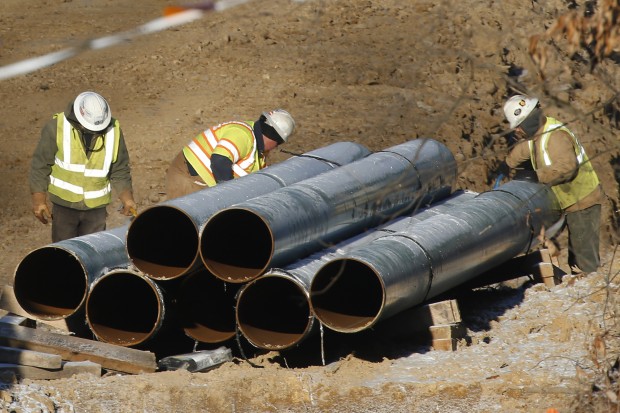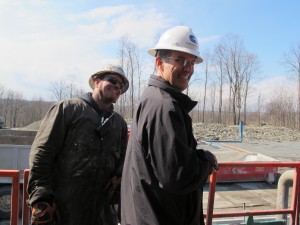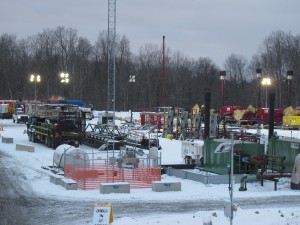Marcellus output flat amid falling prices, slack demand, pipeline shortage
-
Jon Hurdle

Keith Srakocic / AP Photo
Workers install a new shale gas pipeline in Zelienople, Pa. The slow down in production is due in part, to a lack of pipeline infrastructure in the state.
Natural gas production from Pennsylvania’s Marcellus and Utica shales showed little change in 2015 as energy companies deferred expansion plans amid falling prices, sluggish demand growth, and a continuing shortage of pipelines to take the state’s abundant gas to market.
Data from the state’s Department of Environmental Protection show unconventional gas production from the two fields totaled 3.89 billion cubic feet in October, the latest month for which data are available, slightly down from the 3.90 billion cubic feet reported for January of last year.
In the Marcellus, which accounts for the vast majority of the production, the stagnant picture follows a 30 percent increase in 2014 – when prices were about twice what they are now — to about 4 trillion cubic feet, or some 16 percent of total U.S. annual consumption.
The latest stagnation in output reflects slumping market prices which make it harder for energy companies to invest in new wells. Natural gas futures on the New York Mercantile exchange closed at $2.33 per million BTUs on Jan. 4, up $1.06 on a week earlier, as the late arrival of colder weather finally boosted demand, but down 66 cents compared with a year earlier, according to the U.S. Energy Information Administration.
In mid-December, the NYMEX priced dropped to $1.75, its lowest since 1999. The EIA said the natural gas spot price at the Henry Hub, a national benchmark in Louisiana, dropped to an average of $2.61 in 2015, the lowest annual average since 1999.
“Low prices deter new production,” said Kevin Book, an analyst at ClearView Energy Partners, a research company in Washington, DC. “One of the things that is first to suffer is your highest-cost, least-productive well.”
Book said Marcellus output growth has suffered because of the widely publicized shortage of pipelines, and because demand from electricity generators and consumers has shown little growth.
Electric generators’ use of gas surged in the last several years as energy companies retired coal-fired plants and began to comply with tighter air-quality regulations at state and federal levels. But the switching from coal to gas is now likely to slow until the start of the 2020s, Book said.
“There are still some gains from fuel switching to be had, but a lot of it has already been played out,” Book said. “The next wave of switching isn’t likely to come until the next decade.”

Susan Phillips / StateImpact Pennsylvania
Cabot Oil and Gas public relations officer George Stark with a drill rig worker outside of the “dog house,” on a rig in 2012 when gas drilling was booming.
At the consumer level, demand has been depressed by a winter that was unusually mild until early January, Book said.
The combination of sluggish demand and plentiful supply exacerbate an imbalance between the quantity of gas in the Marcellus and the ability to supply it to markets, he said.
“There’s more gas to be had in the Marcellus than there is pipeline capacity to convey it to market,” he said. “There is also more gas to be had in the Marcellus than there is accessible market right now.”
Whether gas companies can make money in the Marcellus with prices at current levels depends on the capital structure of each company, Book said, noting that some are losing money with the price at $2 while others could still break even if the price dropped to $1.
Despite the slack demand currently, Pennsylvania’s abundant gas resources are likely to find a big market overseas in the future when the U.S. begins to export liquefied natural gas to lucrative foreign markets from a series of U.S. export terminals that are currently under construction, Book said.
While some companies have cut their rig counts or deferred expansion, others are combining their operations to cope with the low-price environment. In early December, National Fuel Gas Company, the parent company of Seneca Resources, announced an agreement with IOG CRV Marcellus, a unit of the energy investment firm IOG Capital, to jointly develop up to 80 Marcellus wells in north-central Pennsylvania.
National Fuel chief executive Ronald Tanski said the agreement would allow the company to pursue its strategy of developing Appalachia acreage and building pipelines despite the drop in revenue caused by lower prices.

Susan Phillips / StateImpact Pennsylvania
A Seneca Resources well site in Tioga County during boom times in 2012.
“During this period of lower commodity prices, where we are experiencing decreased cash flow in the upstream portion of our business, the drilling joint development agreement we announced today helps us move forward with our strategy,” Tanski said in a statement on Dec. 2. He said the agreement “significantly reduces” National Fuel’s capital requirements for its upstream operations.
State officials declined to comment on market conditions.
Neil Shader, a spokesman for the DEP – whose published data are subject to change as individual companies submit unaudited figures — declined to say why production was flat in 2015 but said a shortage of pipelines is contributing to the problem.
“The lack of pipeline infrastructure has been cited by the industry as a major impediment that has stranded gas and depressed market prices,” Shader said.
He said that Gov. Tom Wolf’s Pipeline Infrastructure Task Force, which is due to submit its recommendations on Pennsylvania’s massive pipeline buildout in February, is designed to identify best practices that will allow the gas to get to market while protecting landowners, citizens and the environment.
DEP Secretary John Quigley has estimated that Pennsylvania could have as many as 30,000 miles of pipeline in the next 20 years. Current efforts to increase pipeline capacity include Sunoco Logistics’ planned Mariner East 2 pipeline which would take natural gas liquids 350 miles from the Marcellus Shale in southwestern Pennsylvania to a terminal at Marcus Hook on the Pennsylvania/Delaware border.
















